#windows bootloader
Explore tagged Tumblr posts
Text

This is what we want to see!
Operating in full Tired Chaotic Dumbass mode last night when I was trying to get the new external disk set up, what did I manage to do? Wipe out the boot partition on the WRONG DRIVE. Because of course I did.
So yeah, everything else on the drive was fine, but I couldn't boot into anything there.
After a little internal screaming and more than a little cursing myself, the best plan forward looked like getting the system up and running to boot off the new drive as I had intended, downloading a Windows 11 install ISO from there, and then hauling my stupid ass to bed for a brain reset.
But, this afternoon I did successfully get a working EFI partition and Windows bootloader back on the internal drive!
That does work the same on 11.
And, a very similar procedure if you didn't manage to fuck up the whole partition like I did, but just the Windows bootloader files:
But yeah, I did test and it's booting fine now.
In an enlarged partition too, since I decided to migrate my existing MX install over onto the new drive. Because yeah they make it easy to do that:
Thankfully I had already written the (gigantic) ISO and burned it to a USB before I accidentally wiped the boot partition. Was trying to get the new drive set up for it when that happened.
2 notes
·
View notes
Text

for the first time since upgrading to win11, i finally got my beautiful boot menu back! (after tons of research and terminal typing ofc)
#tinkering#grub#bootloader#customization#grand unified bootloader#linux#windows 11#aesthetic tech#nerd stuff
12 notes
·
View notes
Text

normal windows
#windows#windows 10#windows 11#debian#linux#KDE Plasma#foss#FOSS#okay i just installed debian but the grub bootloader seems to have locked me out of my windows drive#i can still access my files though
5 notes
·
View notes
Text

shim Bootloader mit Risiko "hoch"
Update inzwischen verfügbar
Der Open Source Linux Bootloader "shim" enthält eine Sicherheitslücke, mit der Angreifer eigenen Code einschleusen können. Die Warnung CVE-2023-40547 (CVSS 8.3, Risiko "hoch") beschreibt die Gefahr, dass bei einem solchen "Man in the Middle" Angriff in Speicherbereiche außerhalb des allokierten Bereichs geschrieben werden kann (Out-of-bound write primitive). Damit kann das ganze System kompromittiert werden.
Der einzige Zweck von shim als eine "triviale EFI-Applikation" ist der, dass damit auf handelsüblichen Windows-Computern auch andere vertrauenswürdige Betriebssysteme mit Secure Boot zu starten sind. Microsoft macht es mit SecureBoot und seinen EFI/UEFI Bootloadern anderen Systemen weiterhin schwer als System neben Windows installiert zu werden.
Ein Update auf shim 5.18 korrigiert die Sicherheitslücke und repariert auch weitere Schwachstellen. So war erst im Dezember 2023 eine Lücke im Secure-Boot auf BIOS-, bzw. UEFI-Ebene unter dem Namen "LogoFAIL" bekannt geworden.
Mehr dazu bei https://www.heise.de/news/Bootloader-Luecke-gefaehrdet-viele-Linux-Distributionen-9624201.html
Kategorie[21]: Unsere Themen in der Presse Short-Link dieser Seite: a-fsa.de/d/3yU Link zu dieser Seite: https://www.aktion-freiheitstattangst.org/de/articles/8678-20240210-shim-bootloader-mit-risiko-hoch.html
#Microsoft#Windows#Diskriminierung#Ungleichbehandlung#OpenSource#Linux#Bootloader#UEFI#Cyberwar#Hacking#Trojaner#Verbraucherdatenschutz#Datenschutz#Datensicherheit#Datenpannen
1 note
·
View note
Text
How to Repair the Windows Bootloader in a Dual-Boot System with Ubuntu
Hey there, tech enthusiasts! 🌟 Are you struggling with a broken Windows bootloader in your dual-boot setup with Ubuntu? You've come to the right place! Today, I'll guide you through a straightforward process to get both your Windows and Ubuntu systems back on track.
📌 Prerequisites
A bootable Windows installation media (USB or DVD)
A bootable Ubuntu installation media (optional but useful for updating GRUB)
🛠️ Step-by-Step Guide
Step 1: Boot from Windows Installation Media
Insert your Windows installation media and restart your computer. Boot from the media and choose "Repair your computer" > "Troubleshoot" > "Command Prompt".
Step 2: Run DiskPart to Assign a Drive Letter
Open the command prompt and type the following commands:
diskpart list disk select disk 0 (or the disk where Windows is installed) list partition select partition 1 (or your EFI partition) assign letter=z exit
🔍 Note: The letter z is just a placeholder; you can choose any unused letter!
Step 3: Navigate to EFI Partition and Run FixBoot
Once you've assigned a letter, navigate to the EFI partition and attempt to fix the boot issue:
cd /d z:\EFI\Microsoft\Boot\ bootrec /fixboot
⚠️ Heads Up: If you get an "Access Denied" message, double-check that you've correctly assigned a drive letter to your EFI partition.
Step 4: Rebuild BCD
Try rebuilding the Boot Configuration Data (BCD) next:
bootrec /rebuildbcd
🔍 Note: If it still shows 0 installations, manually create a new BCD entry:
bcdboot C:\Windows /l en-us /s z: /f ALL
Remember to replace C:\Windows with your actual Windows installation path and z: with your EFI partition letter.
Step 5: Exit and Reboot
Type exit to close the Command Prompt and reboot your system.
Step 6: (Optional) Update GRUB from Ubuntu
This is an optional step but it's good practice:
sudo update-grub
Step 7: Reboot Your System
Now, you should see a boot menu allowing you to choose between Windows and Ubuntu. Select, boot, and enjoy!
🎉 Wrapping Up
That’s it, folks! You've successfully repaired your Windows bootloader. Remember, these steps can be sensitive to your specific system configuration, so proceed with caution. Always back up your important data before attempting any form of boot repair.
Happy computing! 💻✨
1 note
·
View note
Text
If the problem is cause by Microsoft themselves and I can't bypass it their offices WILL explode, personally
With each passing moment I spend having pc problems I bet 0.0001% more annoyed at Microsoft. When it reaches 100% their office will explode. This will not take as long as it might seem
#Copilot bloatware#Artificial language limits that you have to pay to remove in certain versions#Not supporting any controllers but XInput for Xbox#Changing the bootloader so that it prevents you from having Linux instalations accesible from the Windows Bootloader#etc#at least all of these have workarounds with varying degrees of complexity#let's hope it stays like that
8 notes
·
View notes
Text
Shit what the fuck just happened? Did Windows randomly decide to overwrite grub? Both my drives seem to have the Windows bootloader on now. I can't even access the EFI partition from Windows and I'm unable to boot into Linux now?
18 notes
·
View notes
Note
dualbooting on computers
(the practice of installing two different OSes on one hard drive, oft unified under one bootloader)
I think it's pretty obvious but

(picture above is a picture of the GRUB bootloader version 2.02, with options reading as: "Ubuntu", "Advanced options for Ubuntu", "Memory test (memtest86+)", "Memory test (memtest86+, serial console 115200), and "Windows 7 (loader) (on /dev/sda1)")
!!
Rating: i dont know anything about computers like this, but robots are plural so ! and this sounds even more plural !!!
#didosdd#did#osdd#osdd system#endos dni#anti endo#plural#plurality#plural system#did system#actually dissociative#complex dissociative disorder#dissociative identity disorder#actually did#actually osdd#did osdd#osddid#mod 🦉#plural rating
9 notes
·
View notes
Note
<Denko> .
<Denko> Nope, not letting that happen.
( . . . )
( Writer is literally in Coel's machine now. )
( Bitch what-- )
( The computer is.. actually running on Windows. Strange. )
The fuck?
VM bootloader trap? Out of fuckin' anything..
Goddammit.
( Coel clicks through a few folders and files, looking around for something, not even noticing the Writer. )
10 notes
·
View notes
Text
Update: went from a bunch of loose parts and roughly 200,000,000 screws to a computer that turns on when you press the button in a single day. First PC I've ever built btw.
Wanna take some pictures to put up here but it's late and I gotta sleep, so that's gonna be a tomorrow thing(if I don't just crash due to how much I did today).
Good thing: All the parts are here and I can get to work on building the new computer
Bad thing: this step right here makes me feel dirty

#im so fucking cool#its really pretty too#in my 100% completely absolutely unbiased opinion#honestly really excited for this#first time ive felt like this in a long time#dreading the fact that the first thing im gonna have to do is inflict windows on it#thanks for the $100 os that doesnt play nice with other bootloaders and shows people ads microsoft#pc build journey#my post
2 notes
·
View notes
Note
How long did it take you to get comfortable and NixOS?
For doing most stuff, probably around one to two weeks (mostly spent configuring my WM and shell)
i still don't know a lot about configuring complex stuff with flakes or writing my own packages/derivations, but i don't really need that rn
The main problem is getting used to the completely new way of configuring anything on your system. Here i am listing some of the weird and nice things on NixOS (huge rant)
I haven't touched my /etc directory AT ALL on my install (aside from /etc/nixos)
Everything can be done in /etc/nixos/configuration.nix (and /etc/nixos/flake.nix), even configuring stuff like your window manager (usually done in your home directory) or creating systemd units
You are not really supposed to install packages via the CLI, you add a list of the packages you want installed in your configuration.nix
This makes your system easily reproducible. You have a lock file that locks packages versions
If you make a mistake configuring most things you can roll your configuration back from the bootloader (sick feature)
On the downside, you are sometimes fighting the system because nothing works like you expect (for example, scripts that expect /bin/bash to exist do not work, it simply doesn't exist) (the only file in /bin is sh)
Additionally, you are supposed to do code development in dev shells (like venvs), which is also something to get used to
Also the syntax can sometimes be finicky and you will be fighting it a lot if you want to achieve some complex things (very frustrating)
NixOS is definitely an amazing distro (all my future systems will run on nix) and I can only recommend it if you have the time to get used to it. Never regretted switching away from Arch to it (and I love Arch)
I could probably rant about NixOS for hours... (i tried to keep this one short)(yes really)
16 notes
·
View notes
Note
I currently don’t have a working pc/laptop.
When I get a new pc/laptop, could i just install linux from the start? (assuming windows isn’t preinstalled, or if it is, install linux over it) (free open source software is cool)
Microsoft, as a company, sells their Windows to the computer brands. When you get a desktop PC, it may not have come with Windows if you build it! But if you buy a laptop, it is almost guaranteed it'll come with Windows with the expection being FreeDOS laptops. FreeDOS laptops dont come with any OS, and cuz of this they are a lil bit cheaper!
When ur pc comes with Windows, it is pretty easy to completely delete it and install linux from the USB ! Or, doing the dualbooting!
But remember, there is a small rule in this;
Do not install linux FIRST, then install Windows NEXT.
Windows is a nasty bastard and if you install it AFTER linux, it will just completely mess up the linux's bootloader and ghost it. This happens lile 99% so, either completely delete Windows with the intention to never use it again, OR jus give Windows small disk space and let two of them exist!
When you first start with linux, you never know when you'll gonna be need Windows. I myself virtualise Windows in my linux if i reeaallyy need it and do my thing there, am lazy lol
22 notes
·
View notes
Text
I have two hard drives in my computer: one 500GB SSD (disk 0), and one 1TB SSD (disk 1). Based on my personal experience, I've found this computer to be horribly incompatible with just about everything. For whatever reason, I tried installing Linux Mint, and it went pretty good. That was until it installed the bootloader on disk0 without detecting my Windows installation on disk1, pretty much making my Windows installation inaccessible. This would've been easy to fix if I could make Windows 10 boot media, but I couldn't get an ISO or any software to make boot media because the Wi-FI just decided to stop working when I restarted the computer (I don't even have an Ethernet port in my house). I have a physical copy of Windows 10 lying around, but it's from 2016, so it has a USB driver that causes all of the connected USB devices on my computer (including keyboard/mouse) to stop working. I'm so fucking sick of how incompatible this garbage custom-build tower PC is, I'm so close to just getting a ThinkPad or something.
Hopefully, I'll be able to use one of my spare computers to make Windows 10 boot media and save the Windows 10 installation on my PC, but I honestly just don't want to at this point.
4 notes
·
View notes
Text
basically an alternative init system assumes you already know what you're doing to some degree, so it lets you customize (or outright remove) some features like logging verbosity or multithreading. Some of these settings can whittle down on things like boot time or memory usage.
Though in all honesty, most modern hardware can boot in under 20 seconds even on systemd, so unless you really want to optimize resource usage just use the one you're most comfortable with.
despite my quite chilly sounding name, i'm actually extremely hot and sexy
#i know it's not good practice to say “most modern hardware can take it so whatever”#but if the standard is Windows Bootloader i'm sure we can schedule that fight for another time
48 notes
·
View notes
Text
I use Arch, BTW
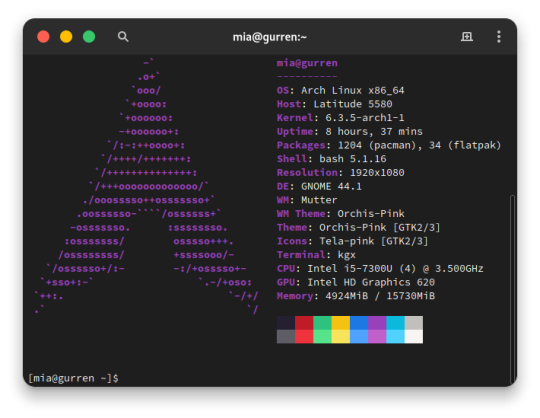
I made the switch from Ubuntu 23.04 to Arch Linux. I embraced the meme. After over a decade since my last failed attempt at daily driving Arch, I'm gonna put this as bluntly as I can possibly make it:
Arch is a solid Linux distribution, but some assembly is required.
But why?
Hear me out here Debian and Fedora family enjoyers. I have long had the Debian family as my go-to distros and also swallowed the RHEL pill and switched my server over to Rocky Linux from Ubuntu LTS. on another machine. More on that in a later post when I'm more acclimated with that. But for my personal primary laptop, a Dell Latitude 5580, after being continually frustrated with Canonical's decision to move commonly used applications, particularly the web browsers, exclusively to Snap packages and the additional overhead and just weird issues that came with those being containerized instead of just running on the bare metal was ultimately my reason for switching. Now I understand the reason for this move from deb repo to Snap, but the way Snap implements these kinds of things just leaves a sour taste in my mouth, especially compared to its alternative from the Fedora family, Flatpak. So for what I needed and wanted, something up to date and with good support and documentation that I didn't have to deal with 1 particular vendors bullshit, I really only had 2 options: Arch and Gentoo (Fedora is currently dealing with some H264 licensing issues and quite honestly I didn't want to bother with that for 2 machines).
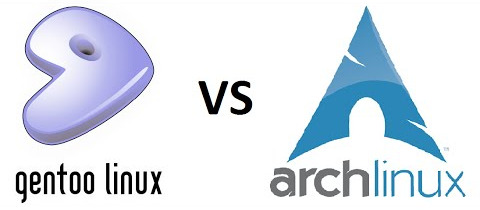
Arch and Gentoo are very much the same but different. And ultimately Arch won over the 4chan /g/ shitpost that has become Gentoo Linux. So why Arch? Quite honestly, time. Arch has massive repositories of both Arch team maintained and community software, the majority of what I need already packaged in binary form. Gentoo is much the same way, minus the precompiled binary aspect as the Portage package manager downloads source code packages and compiles things on the fly specifically for your hardware. While yes this can make things perform better than precompiled binaries, the reality is the difference is negligible at best and placebo at worst depending on your compiler settings. I can take a weekend to install everything and do the fine tuning but if half or more of that time is just waiting for packages to compile, no thanks. That plus the massive resource that is the Arch User Repository (AUR), Arch was a no-brainer, and Vanilla arch was probably the best way to go. It's a Lego set vs 3D printer files and a list of hardware to order from McMaster-Carr to screw it together, metaphorically speaking.
So what's the Arch experience like then?
As I said in the intro, some assembly is required. To start, the installer image you typically download is incredibly barebones. All you get is a simple bash shell as the root user in the live USB/CD environment. From there we need to do 2 things, 1) get the thing online, the nmcli command came in help here as this is on a laptop and I primarily use it wirelessly, and 2) run the archinstall script. At the time I downloaded my Arch installer, archinstall was broken on the base image but you can update it with a quick pacman -S archinstall once you have it online. Arch install does pretty much all the heavy lifting for you, all the primary options you can choose: Desktop environment/window manager, boot loader, audio system, language options, the whole works. I chose Gnome, GRUB bootloader, Pipewire audio system, and EN-US for just about everything. Even then, it's a minimal installation once you do have.
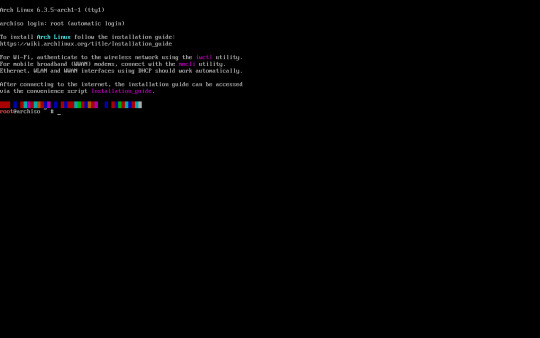
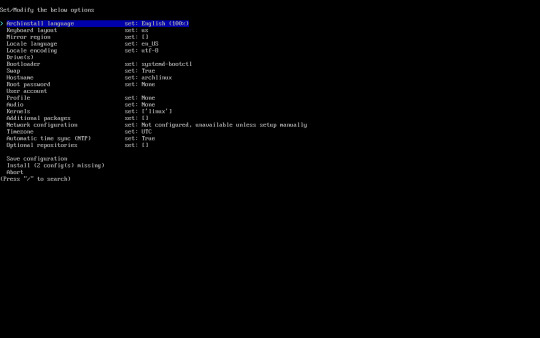
Post-install experience is straightforward, albeit just repetitive. Right off the archinstall script what you get is relatively barebones, a lot more barebones than I was used to with Ubuntu and Debian Linux. I seemingly constantly was missing one thing for another, checking the wiki, checking the AUR, asking friends who had been using arch for even longer than I ever have how to address dumb issues. Going back to the Lego set analogy, archinstall is just the first bag of a larger set. It is the foundation for which you can make it your own further. Everything after that point is the second and onward parts bags, all of the additional media codecs, supporting applications, visual tweaks like a boot animation instead of text mode verbose boot, and things that most distributions such as Ubuntu or Fedora have off the rip, you have to add on yourself. This isn't entirely a bad thing though, as at the end if you're left with what you need and at most very little of what you don't. Keep going through the motions, one application at a time, pulling from the standard pacman repos, AUR, and Flatpak, and eventually you'll have a full fledged desktop with all your usual odds and ends.
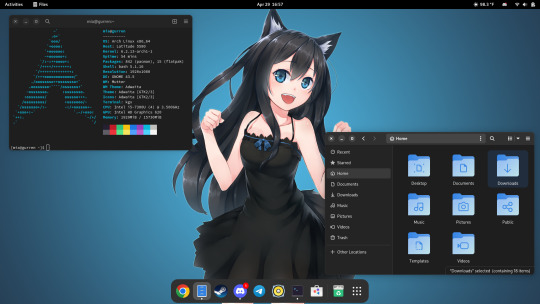
And at the end of all of that, what you're left with is any other Linux distro. I admit previously I wrote Arch off as super unstable and only for the diehard masochists after my last attempt at running Arch when I was a teenager went sideways, but daily driving it on my personal Dell Latitude for the last few months has legitimately been far better than any recent experiences I've had with Ubuntu now. I get it. I get why people use this, why people daily drive this on their work or gaming machines, why people swear off other distros in favor of Arch as their go to Linux distribution. It is only what you want it to be. That said, I will not be switching to Arch any time soon on mission critical systems or devices that will have a high run time with very specific purposes in mind, things like servers or my Raspberry Pi's will get some flavor of RHEL or Debian stable still, and since Arch is one of the most bleeding edge distros, I know my chance of breakage is non zero. But so far the seas have been smooth sailing, and I hope to daily this for many more months to come.
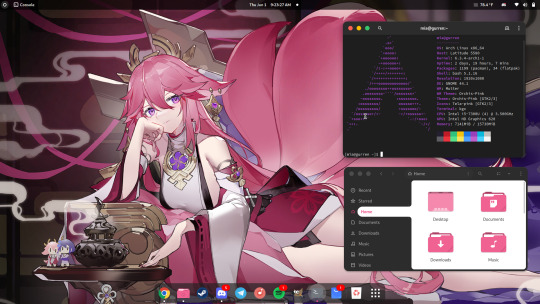
36 notes
·
View notes
Text
I haven't had Bootloader Loop issues on my Windows laptop but it's been a bit glitchy anyways
#whenever some UI element doesn't show or freezes up I have to enter task manager#but in both cases I had steam open so maybe it's steam
2 notes
·
View notes